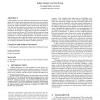Free Online Productivity Tools
i2Speak
i2Symbol
i2OCR
iTex2Img
iWeb2Print
iWeb2Shot
i2Type
iPdf2Split
iPdf2Merge
i2Bopomofo
i2Arabic
i2Style
i2Image
i2PDF
iLatex2Rtf
Sci2ools
89
Voted
NOSSDAV
2004
Springer
2004
Springer
Connectivity restrictions in overlay multicast
A large number of overlay multicast protocols have been developed, almost all of which assume universal connectivity between end hosts. However, in reality, this assumption is not valid with widespread use of Network Address Translators (NAT) and firewalls. The impact of NAT and firewall connectivity restrictions on overlay multicast, especially in the application-endpoint setting, has not been seriously considered. In this paper, we argue that it is critical to consider connectivity restrictions because NAT and firewall hosts make up a large fraction of the endpoints, affecting proper functionality as well as performance of overlay multicast protocols. We present several design enhancements that explicitly consider connectivity restrictions in overlay multicast and evaluate the design space and tradeoffs based on real Internet broadcasts and Internet testbed experiments. Categories and Subject Descriptors C.2.4 [Computer-Communication Networks]: Distributed Systems General Terms D...
Connectivity Restrictions | NOSSDAV 2004 | Operating Systems | Overlay Multicast | Overlay Multicast Protocols |
Related Content
| Added | 02 Jul 2010 |
| Updated | 02 Jul 2010 |
| Type | Conference |
| Year | 2004 |
| Where | NOSSDAV |
| Authors | Aditya Ganjam, Hui Zhang |
Comments (0)

